Report: Early Childhood Program Design and Linguistic Diversity
VerifiedAdded on 2020/11/23
|9
|2765
|436
Report
AI Summary
This report details the design of an early childhood program with a focus on linguistic diversity and anti-bias teaching. The introduction highlights the importance of early childhood programs and their role in children's development. The main body includes a rationale for addressing linguistic di...
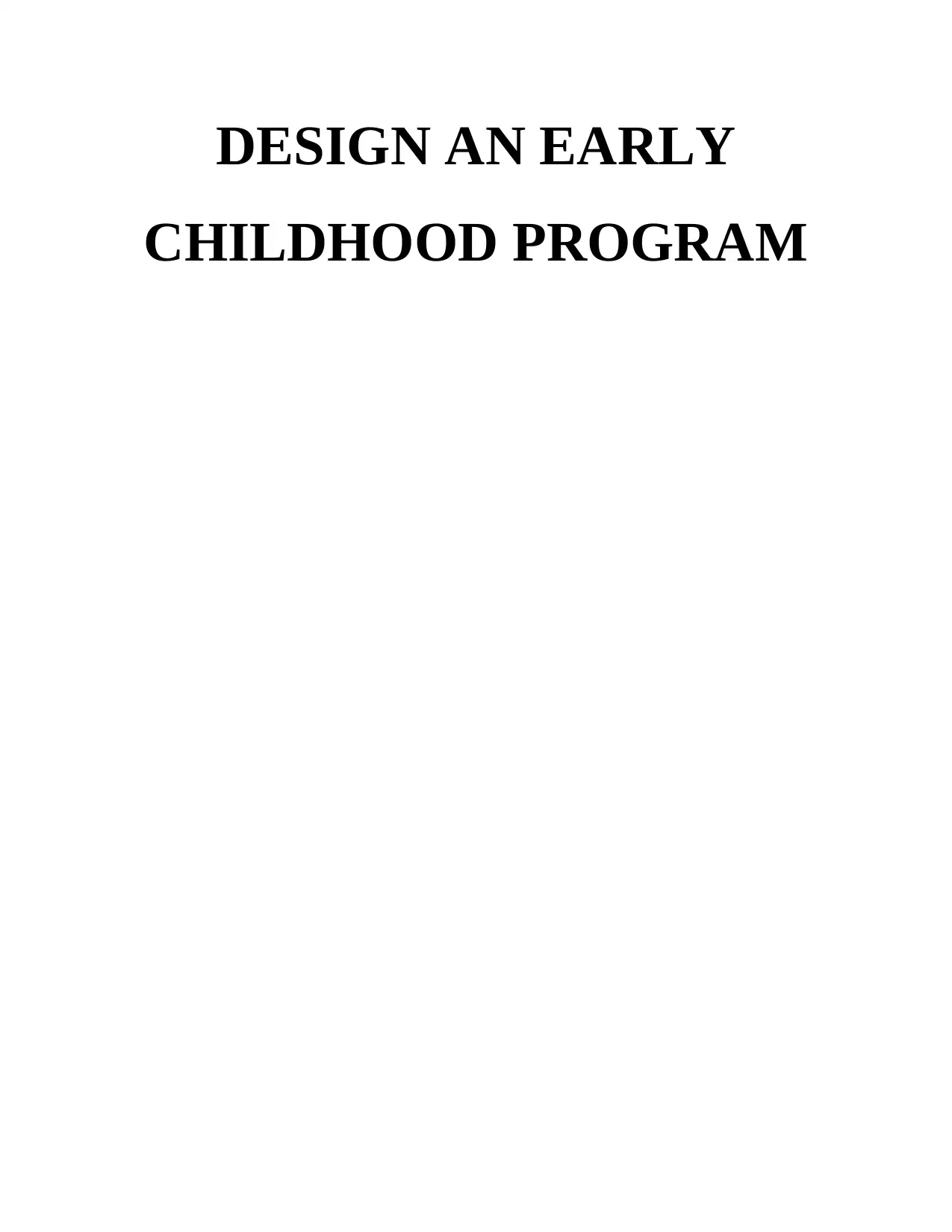
DESIGN AN EARLY
CHILDHOOD PROGRAM
CHILDHOOD PROGRAM
Paraphrase This Document
Need a fresh take? Get an instant paraphrase of this document with our AI Paraphraser

TABLE OF CONTENTS
INTRODUCTION...........................................................................................................................1
MAIN BODY...................................................................................................................................1
1. Rationale on Linguistic Diversity...........................................................................................1
2. Resource Audit........................................................................................................................1
3. Learning Experiences.............................................................................................................2
4. Professional Reflection...........................................................................................................5
CONCLUSION................................................................................................................................5
REFERENCES................................................................................................................................6
INTRODUCTION...........................................................................................................................1
MAIN BODY...................................................................................................................................1
1. Rationale on Linguistic Diversity...........................................................................................1
2. Resource Audit........................................................................................................................1
3. Learning Experiences.............................................................................................................2
4. Professional Reflection...........................................................................................................5
CONCLUSION................................................................................................................................5
REFERENCES................................................................................................................................6
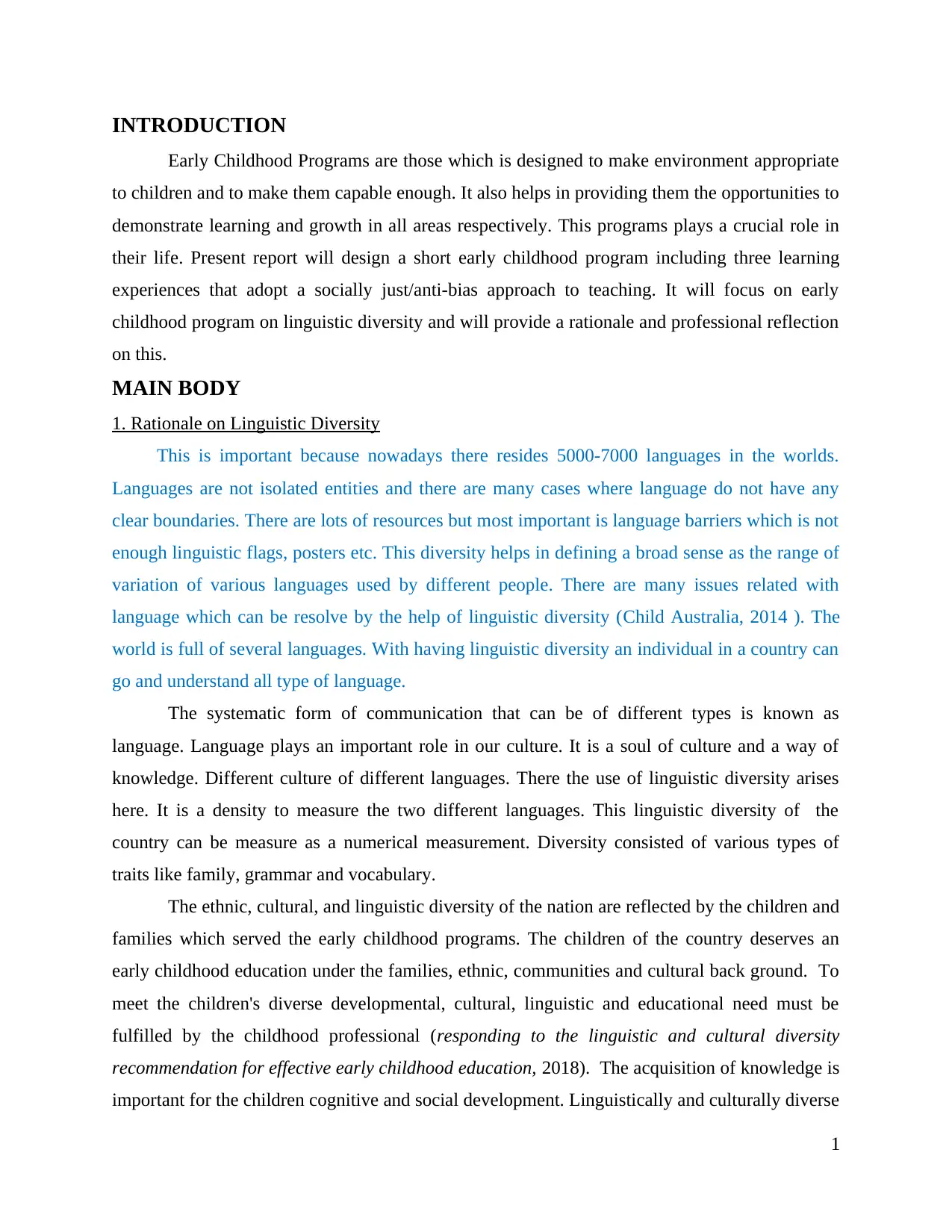
INTRODUCTION
Early Childhood Programs are those which is designed to make environment appropriate
to children and to make them capable enough. It also helps in providing them the opportunities to
demonstrate learning and growth in all areas respectively. This programs plays a crucial role in
their life. Present report will design a short early childhood program including three learning
experiences that adopt a socially just/anti-bias approach to teaching. It will focus on early
childhood program on linguistic diversity and will provide a rationale and professional reflection
on this.
MAIN BODY
1. Rationale on Linguistic Diversity
This is important because nowadays there resides 5000-7000 languages in the worlds.
Languages are not isolated entities and there are many cases where language do not have any
clear boundaries. There are lots of resources but most important is language barriers which is not
enough linguistic flags, posters etc. This diversity helps in defining a broad sense as the range of
variation of various languages used by different people. There are many issues related with
language which can be resolve by the help of linguistic diversity (Child Australia, 2014 ). The
world is full of several languages. With having linguistic diversity an individual in a country can
go and understand all type of language.
The systematic form of communication that can be of different types is known as
language. Language plays an important role in our culture. It is a soul of culture and a way of
knowledge. Different culture of different languages. There the use of linguistic diversity arises
here. It is a density to measure the two different languages. This linguistic diversity of the
country can be measure as a numerical measurement. Diversity consisted of various types of
traits like family, grammar and vocabulary.
The ethnic, cultural, and linguistic diversity of the nation are reflected by the children and
families which served the early childhood programs. The children of the country deserves an
early childhood education under the families, ethnic, communities and cultural back ground. To
meet the children's diverse developmental, cultural, linguistic and educational need must be
fulfilled by the childhood professional (responding to the linguistic and cultural diversity
recommendation for effective early childhood education, 2018). The acquisition of knowledge is
important for the children cognitive and social development. Linguistically and culturally diverse
1
Early Childhood Programs are those which is designed to make environment appropriate
to children and to make them capable enough. It also helps in providing them the opportunities to
demonstrate learning and growth in all areas respectively. This programs plays a crucial role in
their life. Present report will design a short early childhood program including three learning
experiences that adopt a socially just/anti-bias approach to teaching. It will focus on early
childhood program on linguistic diversity and will provide a rationale and professional reflection
on this.
MAIN BODY
1. Rationale on Linguistic Diversity
This is important because nowadays there resides 5000-7000 languages in the worlds.
Languages are not isolated entities and there are many cases where language do not have any
clear boundaries. There are lots of resources but most important is language barriers which is not
enough linguistic flags, posters etc. This diversity helps in defining a broad sense as the range of
variation of various languages used by different people. There are many issues related with
language which can be resolve by the help of linguistic diversity (Child Australia, 2014 ). The
world is full of several languages. With having linguistic diversity an individual in a country can
go and understand all type of language.
The systematic form of communication that can be of different types is known as
language. Language plays an important role in our culture. It is a soul of culture and a way of
knowledge. Different culture of different languages. There the use of linguistic diversity arises
here. It is a density to measure the two different languages. This linguistic diversity of the
country can be measure as a numerical measurement. Diversity consisted of various types of
traits like family, grammar and vocabulary.
The ethnic, cultural, and linguistic diversity of the nation are reflected by the children and
families which served the early childhood programs. The children of the country deserves an
early childhood education under the families, ethnic, communities and cultural back ground. To
meet the children's diverse developmental, cultural, linguistic and educational need must be
fulfilled by the childhood professional (responding to the linguistic and cultural diversity
recommendation for effective early childhood education, 2018). The acquisition of knowledge is
important for the children cognitive and social development. Linguistically and culturally diverse
1
⊘ This is a preview!⊘
Do you want full access?
Subscribe today to unlock all pages.

Trusted by 1+ million students worldwide
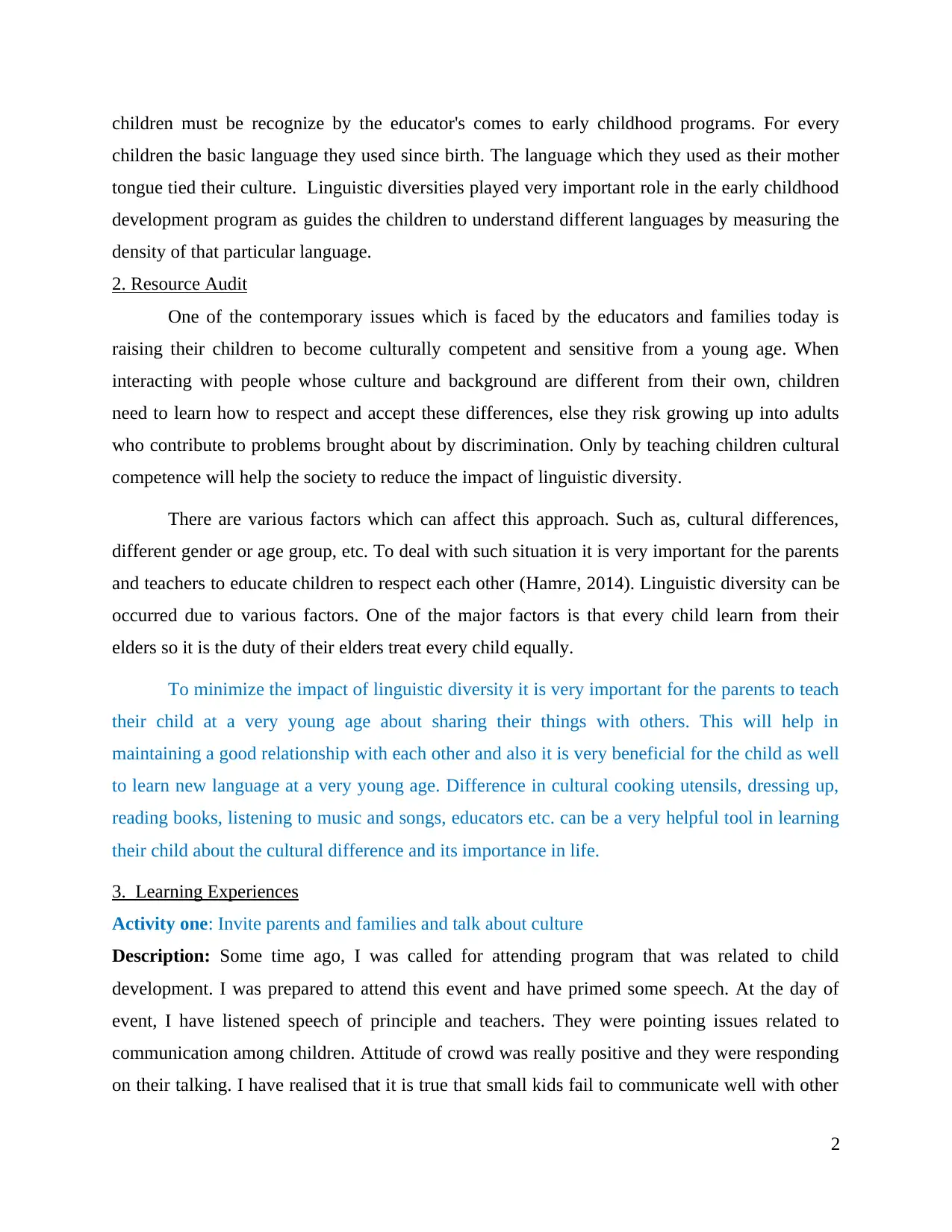
children must be recognize by the educator's comes to early childhood programs. For every
children the basic language they used since birth. The language which they used as their mother
tongue tied their culture. Linguistic diversities played very important role in the early childhood
development program as guides the children to understand different languages by measuring the
density of that particular language.
2. Resource Audit
One of the contemporary issues which is faced by the educators and families today is
raising their children to become culturally competent and sensitive from a young age. When
interacting with people whose culture and background are different from their own, children
need to learn how to respect and accept these differences, else they risk growing up into adults
who contribute to problems brought about by discrimination. Only by teaching children cultural
competence will help the society to reduce the impact of linguistic diversity.
There are various factors which can affect this approach. Such as, cultural differences,
different gender or age group, etc. To deal with such situation it is very important for the parents
and teachers to educate children to respect each other (Hamre, 2014). Linguistic diversity can be
occurred due to various factors. One of the major factors is that every child learn from their
elders so it is the duty of their elders treat every child equally.
To minimize the impact of linguistic diversity it is very important for the parents to teach
their child at a very young age about sharing their things with others. This will help in
maintaining a good relationship with each other and also it is very beneficial for the child as well
to learn new language at a very young age. Difference in cultural cooking utensils, dressing up,
reading books, listening to music and songs, educators etc. can be a very helpful tool in learning
their child about the cultural difference and its importance in life.
3. Learning Experiences
Activity one: Invite parents and families and talk about culture
Description: Some time ago, I was called for attending program that was related to child
development. I was prepared to attend this event and have primed some speech. At the day of
event, I have listened speech of principle and teachers. They were pointing issues related to
communication among children. Attitude of crowd was really positive and they were responding
on their talking. I have realised that it is true that small kids fail to communicate well with other
2
children the basic language they used since birth. The language which they used as their mother
tongue tied their culture. Linguistic diversities played very important role in the early childhood
development program as guides the children to understand different languages by measuring the
density of that particular language.
2. Resource Audit
One of the contemporary issues which is faced by the educators and families today is
raising their children to become culturally competent and sensitive from a young age. When
interacting with people whose culture and background are different from their own, children
need to learn how to respect and accept these differences, else they risk growing up into adults
who contribute to problems brought about by discrimination. Only by teaching children cultural
competence will help the society to reduce the impact of linguistic diversity.
There are various factors which can affect this approach. Such as, cultural differences,
different gender or age group, etc. To deal with such situation it is very important for the parents
and teachers to educate children to respect each other (Hamre, 2014). Linguistic diversity can be
occurred due to various factors. One of the major factors is that every child learn from their
elders so it is the duty of their elders treat every child equally.
To minimize the impact of linguistic diversity it is very important for the parents to teach
their child at a very young age about sharing their things with others. This will help in
maintaining a good relationship with each other and also it is very beneficial for the child as well
to learn new language at a very young age. Difference in cultural cooking utensils, dressing up,
reading books, listening to music and songs, educators etc. can be a very helpful tool in learning
their child about the cultural difference and its importance in life.
3. Learning Experiences
Activity one: Invite parents and families and talk about culture
Description: Some time ago, I was called for attending program that was related to child
development. I was prepared to attend this event and have primed some speech. At the day of
event, I have listened speech of principle and teachers. They were pointing issues related to
communication among children. Attitude of crowd was really positive and they were responding
on their talking. I have realised that it is true that small kids fail to communicate well with other
2
Paraphrase This Document
Need a fresh take? Get an instant paraphrase of this document with our AI Paraphraser
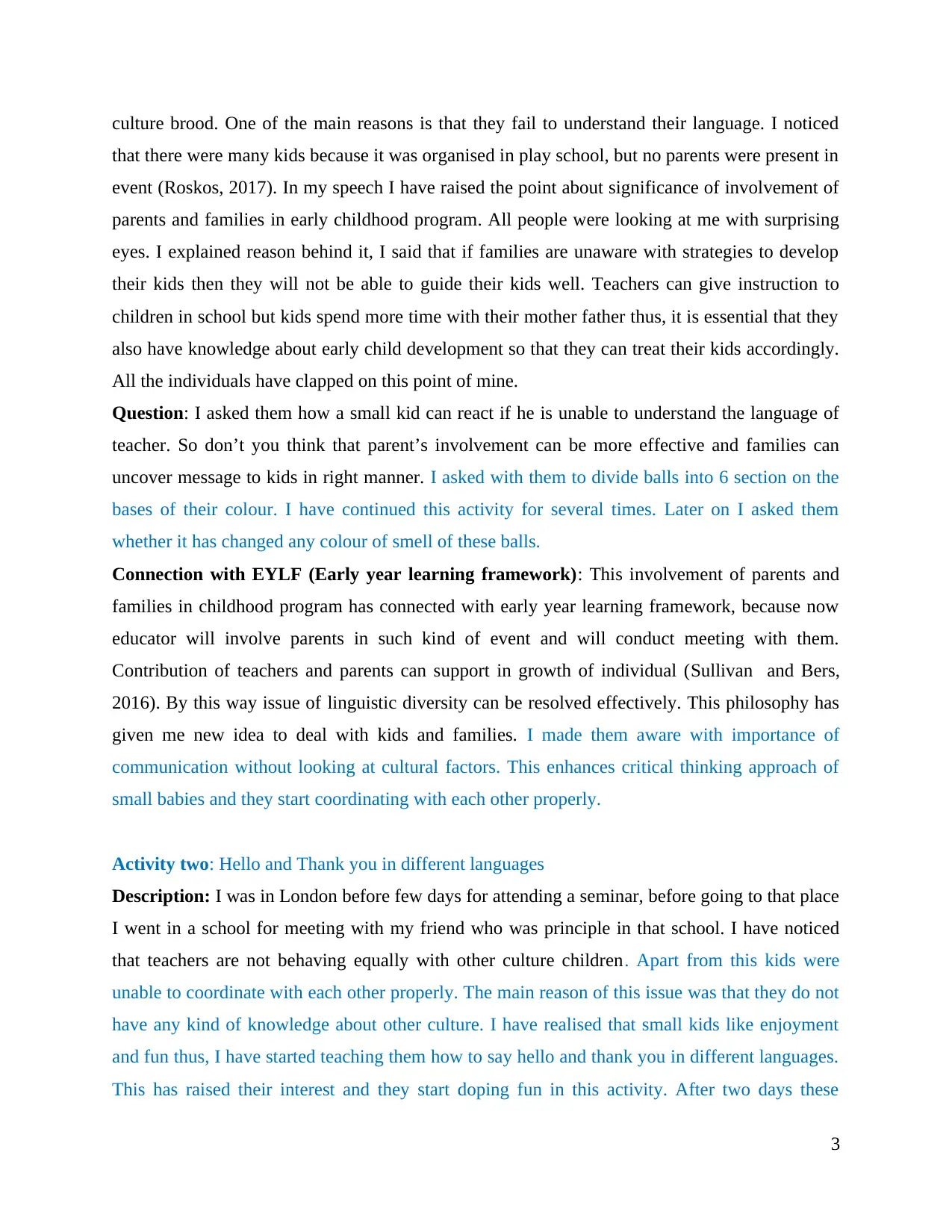
culture brood. One of the main reasons is that they fail to understand their language. I noticed
that there were many kids because it was organised in play school, but no parents were present in
event (Roskos, 2017). In my speech I have raised the point about significance of involvement of
parents and families in early childhood program. All people were looking at me with surprising
eyes. I explained reason behind it, I said that if families are unaware with strategies to develop
their kids then they will not be able to guide their kids well. Teachers can give instruction to
children in school but kids spend more time with their mother father thus, it is essential that they
also have knowledge about early child development so that they can treat their kids accordingly.
All the individuals have clapped on this point of mine.
Question: I asked them how a small kid can react if he is unable to understand the language of
teacher. So don’t you think that parent’s involvement can be more effective and families can
uncover message to kids in right manner. I asked with them to divide balls into 6 section on the
bases of their colour. I have continued this activity for several times. Later on I asked them
whether it has changed any colour of smell of these balls.
Connection with EYLF (Early year learning framework): This involvement of parents and
families in childhood program has connected with early year learning framework, because now
educator will involve parents in such kind of event and will conduct meeting with them.
Contribution of teachers and parents can support in growth of individual (Sullivan and Bers,
2016). By this way issue of linguistic diversity can be resolved effectively. This philosophy has
given me new idea to deal with kids and families. I made them aware with importance of
communication without looking at cultural factors. This enhances critical thinking approach of
small babies and they start coordinating with each other properly.
Activity two: Hello and Thank you in different languages
Description: I was in London before few days for attending a seminar, before going to that place
I went in a school for meeting with my friend who was principle in that school. I have noticed
that teachers are not behaving equally with other culture children. Apart from this kids were
unable to coordinate with each other properly. The main reason of this issue was that they do not
have any kind of knowledge about other culture. I have realised that small kids like enjoyment
and fun thus, I have started teaching them how to say hello and thank you in different languages.
This has raised their interest and they start doping fun in this activity. After two days these
3
that there were many kids because it was organised in play school, but no parents were present in
event (Roskos, 2017). In my speech I have raised the point about significance of involvement of
parents and families in early childhood program. All people were looking at me with surprising
eyes. I explained reason behind it, I said that if families are unaware with strategies to develop
their kids then they will not be able to guide their kids well. Teachers can give instruction to
children in school but kids spend more time with their mother father thus, it is essential that they
also have knowledge about early child development so that they can treat their kids accordingly.
All the individuals have clapped on this point of mine.
Question: I asked them how a small kid can react if he is unable to understand the language of
teacher. So don’t you think that parent’s involvement can be more effective and families can
uncover message to kids in right manner. I asked with them to divide balls into 6 section on the
bases of their colour. I have continued this activity for several times. Later on I asked them
whether it has changed any colour of smell of these balls.
Connection with EYLF (Early year learning framework): This involvement of parents and
families in childhood program has connected with early year learning framework, because now
educator will involve parents in such kind of event and will conduct meeting with them.
Contribution of teachers and parents can support in growth of individual (Sullivan and Bers,
2016). By this way issue of linguistic diversity can be resolved effectively. This philosophy has
given me new idea to deal with kids and families. I made them aware with importance of
communication without looking at cultural factors. This enhances critical thinking approach of
small babies and they start coordinating with each other properly.
Activity two: Hello and Thank you in different languages
Description: I was in London before few days for attending a seminar, before going to that place
I went in a school for meeting with my friend who was principle in that school. I have noticed
that teachers are not behaving equally with other culture children. Apart from this kids were
unable to coordinate with each other properly. The main reason of this issue was that they do not
have any kind of knowledge about other culture. I have realised that small kids like enjoyment
and fun thus, I have started teaching them how to say hello and thank you in different languages.
This has raised their interest and they start doping fun in this activity. After two days these
3
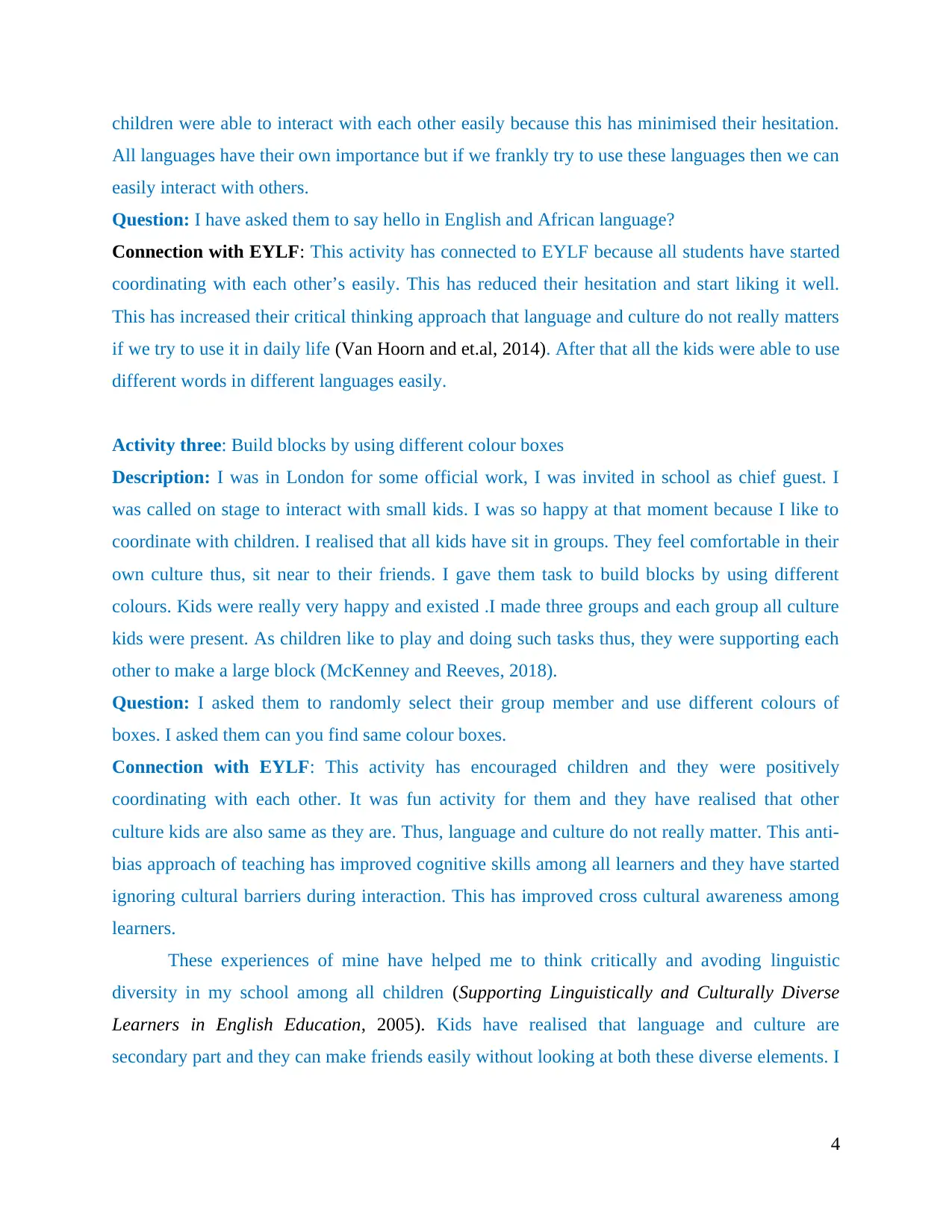
children were able to interact with each other easily because this has minimised their hesitation.
All languages have their own importance but if we frankly try to use these languages then we can
easily interact with others.
Question: I have asked them to say hello in English and African language?
Connection with EYLF: This activity has connected to EYLF because all students have started
coordinating with each other’s easily. This has reduced their hesitation and start liking it well.
This has increased their critical thinking approach that language and culture do not really matters
if we try to use it in daily life (Van Hoorn and et.al, 2014). After that all the kids were able to use
different words in different languages easily.
Activity three: Build blocks by using different colour boxes
Description: I was in London for some official work, I was invited in school as chief guest. I
was called on stage to interact with small kids. I was so happy at that moment because I like to
coordinate with children. I realised that all kids have sit in groups. They feel comfortable in their
own culture thus, sit near to their friends. I gave them task to build blocks by using different
colours. Kids were really very happy and existed .I made three groups and each group all culture
kids were present. As children like to play and doing such tasks thus, they were supporting each
other to make a large block (McKenney and Reeves, 2018).
Question: I asked them to randomly select their group member and use different colours of
boxes. I asked them can you find same colour boxes.
Connection with EYLF: This activity has encouraged children and they were positively
coordinating with each other. It was fun activity for them and they have realised that other
culture kids are also same as they are. Thus, language and culture do not really matter. This anti-
bias approach of teaching has improved cognitive skills among all learners and they have started
ignoring cultural barriers during interaction. This has improved cross cultural awareness among
learners.
These experiences of mine have helped me to think critically and avoding linguistic
diversity in my school among all children (Supporting Linguistically and Culturally Diverse
Learners in English Education, 2005). Kids have realised that language and culture are
secondary part and they can make friends easily without looking at both these diverse elements. I
4
All languages have their own importance but if we frankly try to use these languages then we can
easily interact with others.
Question: I have asked them to say hello in English and African language?
Connection with EYLF: This activity has connected to EYLF because all students have started
coordinating with each other’s easily. This has reduced their hesitation and start liking it well.
This has increased their critical thinking approach that language and culture do not really matters
if we try to use it in daily life (Van Hoorn and et.al, 2014). After that all the kids were able to use
different words in different languages easily.
Activity three: Build blocks by using different colour boxes
Description: I was in London for some official work, I was invited in school as chief guest. I
was called on stage to interact with small kids. I was so happy at that moment because I like to
coordinate with children. I realised that all kids have sit in groups. They feel comfortable in their
own culture thus, sit near to their friends. I gave them task to build blocks by using different
colours. Kids were really very happy and existed .I made three groups and each group all culture
kids were present. As children like to play and doing such tasks thus, they were supporting each
other to make a large block (McKenney and Reeves, 2018).
Question: I asked them to randomly select their group member and use different colours of
boxes. I asked them can you find same colour boxes.
Connection with EYLF: This activity has encouraged children and they were positively
coordinating with each other. It was fun activity for them and they have realised that other
culture kids are also same as they are. Thus, language and culture do not really matter. This anti-
bias approach of teaching has improved cognitive skills among all learners and they have started
ignoring cultural barriers during interaction. This has improved cross cultural awareness among
learners.
These experiences of mine have helped me to think critically and avoding linguistic
diversity in my school among all children (Supporting Linguistically and Culturally Diverse
Learners in English Education, 2005). Kids have realised that language and culture are
secondary part and they can make friends easily without looking at both these diverse elements. I
4
⊘ This is a preview!⊘
Do you want full access?
Subscribe today to unlock all pages.

Trusted by 1+ million students worldwide

found that Social injustice can impact on development of kids to great extent thus, being a
teachers I have to treat all individual equally and help them in their growth.
From the above learning experience it can be justified that it is very important to treat
every child equally. This will help me in making them feel dignified and equal despite of their
cultural background, language barrier, etc (Derman-Sparks and Olsen Edwards, 2010). All these
experiences will help in encouraging children to become critical thinkers and demonstrate a
socially just/anti-bias approach to teaching. From the first learning experience it can be
illustrated that there is a major role of parents in children in shaping their behaviour. They are the
first learning class to them as they spend most of their time with the parents (Britto and et.al.,
2017). They should ensure that they are giving them the right education. From the second
learning experience, it can be demonstrated that, all people and children should be treated
equally. This will help in maintaining a good relationship with each other and respecting them.
And from the third learning experience it can be stated that educators are required to frame
culturally and socially responsible practices for learners which will help them in educating their
children more about the linguistic diversity (Green, 2001).
4. Professional Reflection
I have acknowledged that language barrier can be created due to several reasons. One of
them can be due to involvement of parents as well as families in early childhood programs. It is
very true that children learn from their parents. Therefore, if a gap is created by elders then it
affects communication of children. Apart from this, adults treat indigenous and normal child in
different ways it can create a deep impact on small children. Also, it has been observed that some
parents were differentiating between black and white individual that lead to influence those
children who were observing them in negative way. Therefore, it is needed that educators must
reframe several practices related to cultural as well as social responsibilities. Also, from this
early childhood program it became easy for the teachers as well as for parents in educating their
children at an early age because at this age it is easy for a child to learn new things. From the
three learning experience which took place helped a lot in understanding the importance of
linguistic diversity among people. From this research it can be summarized that communication
plays an important for everyone as it helps in understanding each other better. This learning
experience will help in making every child capable enough to understand what is correct and
what is wrong in life.
5
teachers I have to treat all individual equally and help them in their growth.
From the above learning experience it can be justified that it is very important to treat
every child equally. This will help me in making them feel dignified and equal despite of their
cultural background, language barrier, etc (Derman-Sparks and Olsen Edwards, 2010). All these
experiences will help in encouraging children to become critical thinkers and demonstrate a
socially just/anti-bias approach to teaching. From the first learning experience it can be
illustrated that there is a major role of parents in children in shaping their behaviour. They are the
first learning class to them as they spend most of their time with the parents (Britto and et.al.,
2017). They should ensure that they are giving them the right education. From the second
learning experience, it can be demonstrated that, all people and children should be treated
equally. This will help in maintaining a good relationship with each other and respecting them.
And from the third learning experience it can be stated that educators are required to frame
culturally and socially responsible practices for learners which will help them in educating their
children more about the linguistic diversity (Green, 2001).
4. Professional Reflection
I have acknowledged that language barrier can be created due to several reasons. One of
them can be due to involvement of parents as well as families in early childhood programs. It is
very true that children learn from their parents. Therefore, if a gap is created by elders then it
affects communication of children. Apart from this, adults treat indigenous and normal child in
different ways it can create a deep impact on small children. Also, it has been observed that some
parents were differentiating between black and white individual that lead to influence those
children who were observing them in negative way. Therefore, it is needed that educators must
reframe several practices related to cultural as well as social responsibilities. Also, from this
early childhood program it became easy for the teachers as well as for parents in educating their
children at an early age because at this age it is easy for a child to learn new things. From the
three learning experience which took place helped a lot in understanding the importance of
linguistic diversity among people. From this research it can be summarized that communication
plays an important for everyone as it helps in understanding each other better. This learning
experience will help in making every child capable enough to understand what is correct and
what is wrong in life.
5
Paraphrase This Document
Need a fresh take? Get an instant paraphrase of this document with our AI Paraphraser
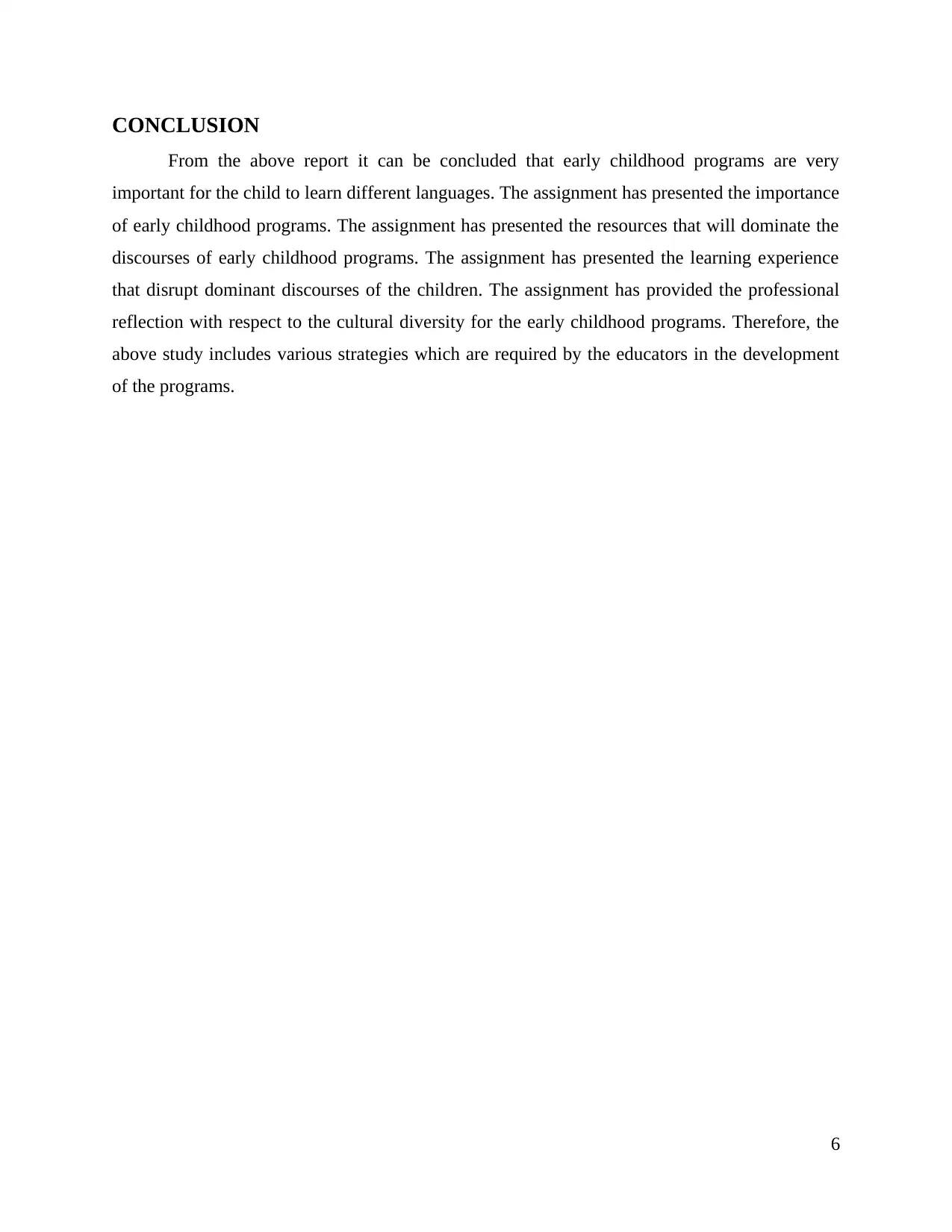
CONCLUSION
From the above report it can be concluded that early childhood programs are very
important for the child to learn different languages. The assignment has presented the importance
of early childhood programs. The assignment has presented the resources that will dominate the
discourses of early childhood programs. The assignment has presented the learning experience
that disrupt dominant discourses of the children. The assignment has provided the professional
reflection with respect to the cultural diversity for the early childhood programs. Therefore, the
above study includes various strategies which are required by the educators in the development
of the programs.
6
From the above report it can be concluded that early childhood programs are very
important for the child to learn different languages. The assignment has presented the importance
of early childhood programs. The assignment has presented the resources that will dominate the
discourses of early childhood programs. The assignment has presented the learning experience
that disrupt dominant discourses of the children. The assignment has provided the professional
reflection with respect to the cultural diversity for the early childhood programs. Therefore, the
above study includes various strategies which are required by the educators in the development
of the programs.
6
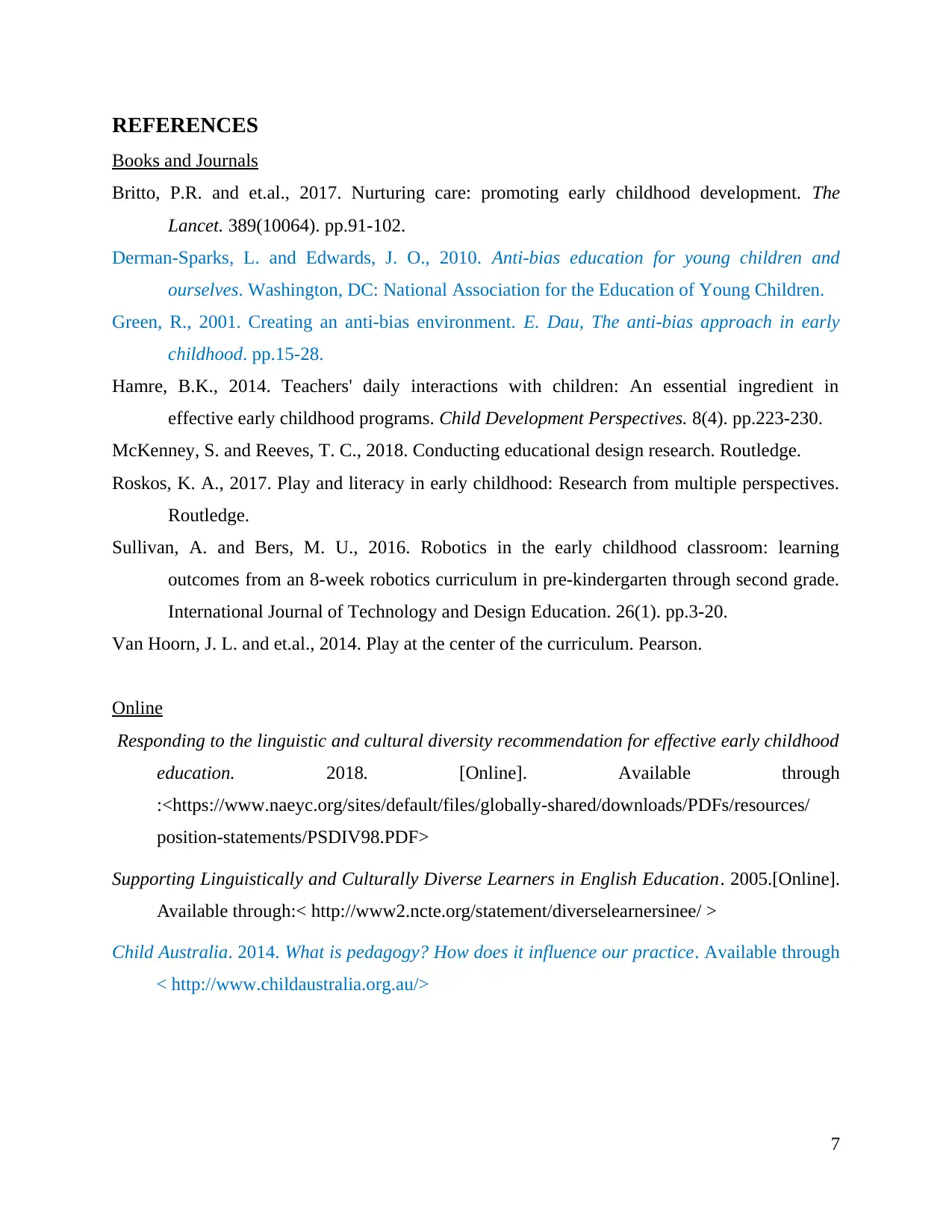
REFERENCES
Books and Journals
Britto, P.R. and et.al., 2017. Nurturing care: promoting early childhood development. The
Lancet. 389(10064). pp.91-102.
Derman-Sparks, L. and Edwards, J. O., 2010. Anti-bias education for young children and
ourselves. Washington, DC: National Association for the Education of Young Children.
Green, R., 2001. Creating an anti-bias environment. E. Dau, The anti-bias approach in early
childhood. pp.15-28.
Hamre, B.K., 2014. Teachers' daily interactions with children: An essential ingredient in
effective early childhood programs. Child Development Perspectives. 8(4). pp.223-230.
McKenney, S. and Reeves, T. C., 2018. Conducting educational design research. Routledge.
Roskos, K. A., 2017. Play and literacy in early childhood: Research from multiple perspectives.
Routledge.
Sullivan, A. and Bers, M. U., 2016. Robotics in the early childhood classroom: learning
outcomes from an 8-week robotics curriculum in pre-kindergarten through second grade.
International Journal of Technology and Design Education. 26(1). pp.3-20.
Van Hoorn, J. L. and et.al., 2014. Play at the center of the curriculum. Pearson.
Online
Responding to the linguistic and cultural diversity recommendation for effective early childhood
education. 2018. [Online]. Available through
:<https://www.naeyc.org/sites/default/files/globally-shared/downloads/PDFs/resources/
position-statements/PSDIV98.PDF>
Supporting Linguistically and Culturally Diverse Learners in English Education. 2005.[Online].
Available through:< http://www2.ncte.org/statement/diverselearnersinee/ >
Child Australia. 2014. What is pedagogy? How does it influence our practice. Available through
< http://www.childaustralia.org.au/>
7
Books and Journals
Britto, P.R. and et.al., 2017. Nurturing care: promoting early childhood development. The
Lancet. 389(10064). pp.91-102.
Derman-Sparks, L. and Edwards, J. O., 2010. Anti-bias education for young children and
ourselves. Washington, DC: National Association for the Education of Young Children.
Green, R., 2001. Creating an anti-bias environment. E. Dau, The anti-bias approach in early
childhood. pp.15-28.
Hamre, B.K., 2014. Teachers' daily interactions with children: An essential ingredient in
effective early childhood programs. Child Development Perspectives. 8(4). pp.223-230.
McKenney, S. and Reeves, T. C., 2018. Conducting educational design research. Routledge.
Roskos, K. A., 2017. Play and literacy in early childhood: Research from multiple perspectives.
Routledge.
Sullivan, A. and Bers, M. U., 2016. Robotics in the early childhood classroom: learning
outcomes from an 8-week robotics curriculum in pre-kindergarten through second grade.
International Journal of Technology and Design Education. 26(1). pp.3-20.
Van Hoorn, J. L. and et.al., 2014. Play at the center of the curriculum. Pearson.
Online
Responding to the linguistic and cultural diversity recommendation for effective early childhood
education. 2018. [Online]. Available through
:<https://www.naeyc.org/sites/default/files/globally-shared/downloads/PDFs/resources/
position-statements/PSDIV98.PDF>
Supporting Linguistically and Culturally Diverse Learners in English Education. 2005.[Online].
Available through:< http://www2.ncte.org/statement/diverselearnersinee/ >
Child Australia. 2014. What is pedagogy? How does it influence our practice. Available through
< http://www.childaustralia.org.au/>
7
⊘ This is a preview!⊘
Do you want full access?
Subscribe today to unlock all pages.

Trusted by 1+ million students worldwide
1 out of 9
Related Documents
Your All-in-One AI-Powered Toolkit for Academic Success.
+13062052269
info@desklib.com
Available 24*7 on WhatsApp / Email
![[object Object]](/_next/static/media/star-bottom.7253800d.svg)
Unlock your academic potential
© 2024 | Zucol Services PVT LTD | All rights reserved.




